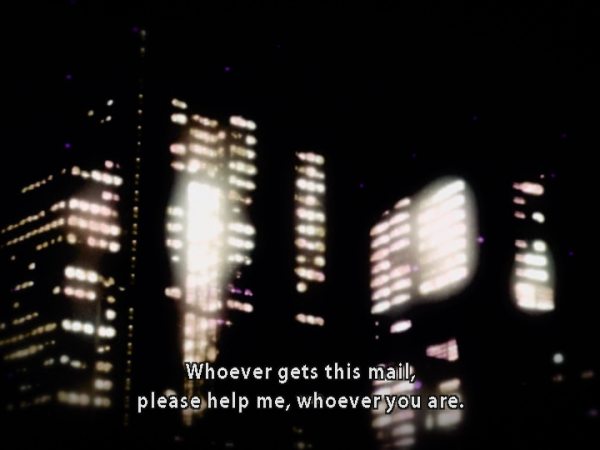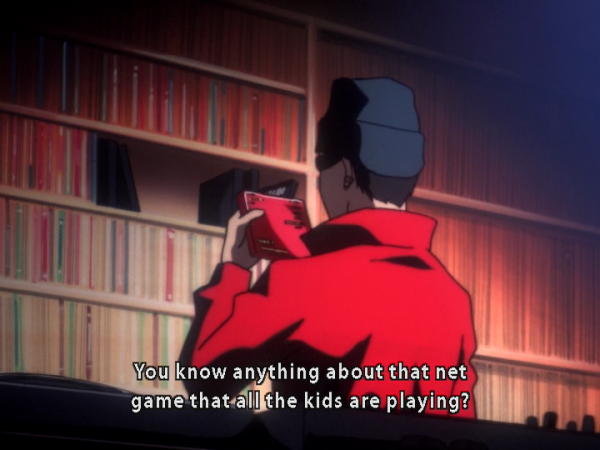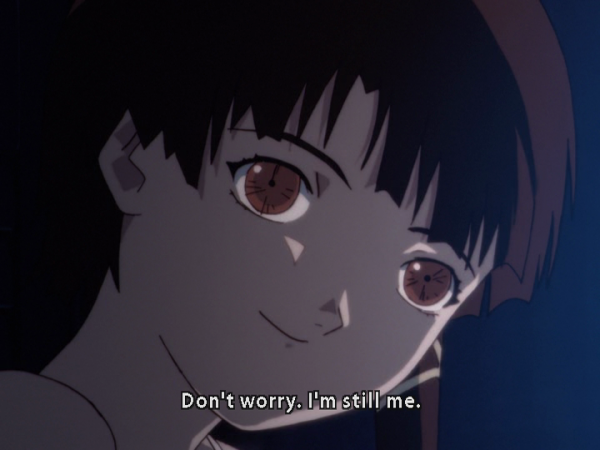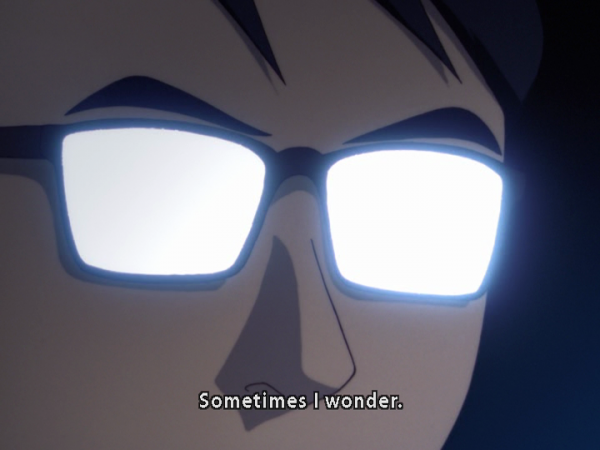Religion
Time for more serial experiments lain. In Layer 04: Religion the cityscape voice-over tells us, “I don’t need parents. Humans are connected to no one, nobody at all.” Mika, Mr. Iwakura, and Alice and friends all note in this episode that Lain has changed, as she’s both livelier and more obsessed with the Wired. Lain’s classmates discuss another apparent suicide, which we learn is connected to a game called Phantoma. The MIBs show up again, but this time Lain notices them and scares them off by destroying the shorter man’s lens, seemingly telepathically. There is also another sequence of speculation on the Knights and various rumours from the Wired.


There are two main points to this episode. One is that the Wired is becoming more tied in to the real world. In particular, an FPS-style game played by high schoolers has been intertwined into a game of tag played by young children, and both are tied into the real world. So, the first young man we see gets killed by his ghostly pursuer, while the second pulls out a gun, unseen but apparently real in the game, which he uses to shoot his pursuer. (Kudos to lain for being one of those shows that isn’t afraid to kill a kid?).
The voice-over message of “Humans are connected to no one” seems out-of-place, given the rest of the show and that the Wired certainly is connecting people in this episode, albeit not exactly in an ideal way. Perhaps it’s an expression of the sort of loneliness that technophiles would like to ease, as well as an indication that not everyone in this world is on board with collapsing the wall between the Wired and the real world.

The other main point is Lain’s change. First, she’s growing more powerful. In this episode we see her communicate to J. J. in Cyberia through the Wired, even though he’s not using any kind of device. She’s also able to destroy the MIB’s lens and, when that child’s game of tag goes south, Lain appears overlooking the scene.


All this is reflected in a change in Lain’s personality, as she becomes a little more like the Lain of the Wired. She’s more obsessed with computers, though still open to an invitation from Alice to spend the afternoon with her, Reika, and Julie.
We also have a conversation between Lain and her father, who warns her not to confuse the Wired with the real world. “It’s just a medium for communication and the transfer of information,” he says. Lain, however, disagrees, much to his surprise. When he held back what he knew about Psyche in the last episode he essentially gave up his early role as a guide for Lain, and now she’s asserting herself as an authority. “The border between the two isn’t all that clear,” she tells him. “I’ll be able to enter it soon. In full range. Full motion. I’ll translate myself into it.” Her statement “Don’t worry, I’m still me” doesn’t give Mr. Iwakura much confidence. Serial experiments lain is fond of extreme close-ups, and the technique works well here - the eyes are “windows to the soul,” and eye contact one of the most important aspects of body language in a conversation, so the glare in his glasses that completely hid his eyes gives a feeling of closure or distance between him and Lain.


to Be continued…
Before we go too much farther into the series, we should probably take a moment to talk about the “Devices” segments. If you’re not sure what I mean, it’s probably because you’re watching Funimation’s release - more on that shortly.
Essentially, these are lain’s version of next episode previews, but instead of showing anything of the next episode besides the title, it tells us the name of a “device,” always a body part like ear, eye, or hand, alongside an EXTREME CLOSE-UP of that body part on Shimizu Kaori, the actress who voiced Lain. Obviously, these do parallel the many such shots in the show itself. Thematically, they reinforce lain’s mechanistic view of the world by reducing our hands, feet, etc. to “devices” that we use to interact with the real world, in much the same way we interact with the internet using devices like our computers, smartphones, keyboards, and so on. They’re also just aesthetically interesting to look at, and though episode previews are common in other anime, few use anything so abstract. Of course, one of the exceptions is Texhnolyze, which as we’ve already seen shared several staff members with lain.

For some reason, American licensors have not been fans of the Devices. In Geneon’s old DVD release, rather than keeping them at the end of the relevant episodes where they belong, they moved them to the end of the disc. So, you’d watch the four episodes on the DVD, then you’d get four next episode previews all in a row. Funimation took this a step further and removed them altogether. This would be annoying enough if these were just standard previews, but at least it would be an understandable move in that case. The normal function of an preview is to get the audience interested in the next episode, but if you already own the blu-ray you’re probably already sold on the rest of the series. However, in this case they’re a small but artistic creation in themselves and part of the creators’ intended experience for the show. I’m hoping that their exclusion was because of some strange rights problem, perhaps because of Shimizu’s live action appearance, but I have no idea. Fortunately, if you are stuck with Funimation’s release they are easy to find on Youtube, so by all means check them out. 